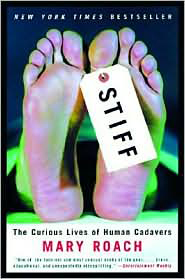Macabre. Gross. Funny, in a twisted, fascinating way. What does happen to our bodies once we are dead and gone? Ashes to ashes and dust to dust, eventually and in most cases, unless you’ve donated your body to science and then the process is either sped up, as it is dipped in a tub of lye, or delayed indefinitely through plastination. In Stiff: The Curious Lives of Human Cadavers, author Mary Roach takes us on a wild romp through history and science, describing in unsettling detail how cadavers have been used, and are used, in medical research. Although the book is weirdly entertaining, given the subject matter, Roach is always respectful of the bodies, and the people who have donated them.
“The human head is of the same approximate size and weight as a roaster chicken. I have never before had occasion to make the comparison, for never before today have I seen a head in a roasting pan. But here are forty of them, one per pan, resting face-up on what looks to be a small pet-food bowl. The heads are for plastic surgeons, two per head, to practice on. I’m observing a facial anatomy and face-lift refresher course, sponsored by a southern university medical center and led by a half-dozen of America’s most sought-after-face-lifters. The heads have been put in roasting pans – which are of the disposable aluminum variety – for the same reason that chickens are put in roasting pans: to catch the drippings. Surgery, even surgery upon the dead, is a tidy, orderly affair.”
In the chapter entitled “Crimes of Anatomy”, Roach takes us back before the time where there was a legal process in place to donate one’s body to science. In the early 1800s teachers of anatomy had to resort to other means of acquiring bodies on which to practice. Body snatching from recently dug graves was the more usual method, and there was a vigorous trade in the practice. The problem was that nobody wanted to be dissected. The common view of life after death was of the whole body making its way to heaven. Dissection was something only done to the bodies of executed mass murderers.

